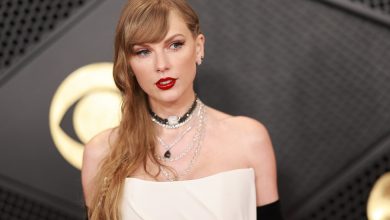Strike First, Strike Hard: How ‘The Karate Kid’ Became a Musical

CHESTERFIELD, Mo. — Robert Mark Kamen was through with “The Karate Kid,” his semi-autobiographical 1984 martial arts film that spawned a string of movies, an animated program and the hit Netflix series “Cobra Kai,” until he saw “Hadestown” in 2019. That’s when he realized: He loved musicals.
“When you watch a movie, the camera is limited to one dimension,” Kamen, 74, said in early May during a break from rehearsals for “The Karate Kid — The Musical,” which is debuting at the new $25 million Kirkwood Performing Arts Center just outside St. Louis. “With this thing, you can have three dimensions, people doing something [pointing] here, here, here, going up and down, around and around, all at the same time. … It opened up so many possibilities.”
An inspired Kamen went back to his hotel — and wrote what would become the opening of a new musical, complete with taiko drums and dancing ancestors. He also called the person who’d sent him to New York as a homework assignment, the producer Kumiko Yoshii, who had been campaigning since 2016 for the rights to “The Karate Kid” franchise, which Kamen owned with Sony Pictures.
“He was so excited and had so many ideas,” Yoshii said. “But at the heart of it all was still the relationship between Daniel and his mentor, Mr. Miyagi.”
The result is a musical adaptation of the classic film about a teenage American boy (Ralph Macchio) who learns martial arts from an Okinawan-born janitor and karate master (Pat Morita, whose performance earned an Oscar nomination) to defeat a high school bully. The musical stars John Cardoza (“Jagged Little Pill”) as Daniel LaRusso, the titular karate kid, and the Canadian actor Jovanni Sy as his mentor, Chojun Miyagi.
Though the plot closely follows that of the original film — the story is still set in the 1980s — the musical’s cast and creative team of more than 40 artists is markedly more diverse.
The director, Amon Miyamoto, was the first — and remains the only — Japanese citizen to direct a show on Broadway (a 2004 revival of the Stephen Sondheim-John Weidman musical “Pacific Overtures”); Keone and Mari Madrid, the married Filipino American choreographers, have worked with Justin Bieber and Billie Eilish and recently directed and choreographed the Britney Spears jukebox musical “Once Upon a One More Time”; and the costume designer Ayako Maeda, has won numerous awards in her native Japan. Kamen wrote the book, and the songwriter Drew Gasparini, known for his work on “Smash,” wrote the music and lyrics.
“It’s an American film,” the director, Miyamoto, 64, said in Japanese via an interpreter during a rehearsal break in early May. “But we’ve added Japanese elements.”
Those elements include putting a greater emphasis on Mr. Miyagi by framing the story as his recollection of events, which Kamen said was his original vision for the film before the filmmakers decided to focus on Macchio’s Daniel. There is also a score by Gasparini that blends pop, rock and Okinawan music; costumes featuring traditional Japanese attire, including a kimono, by Maeda; and a dance-heavy production that fuses the Madrids’ hip-hop choreography style with karate.
“There has to be a reason to adapt it into a musical,” Kamen said. “If we’re doing exactly the same thing as the film, there’s no reason we have to create this for the stage.”
INSIDE A FORMER CHURCH in Chesterfield, Mo., on a Saturday morning in early May, ribbons of light shone through stained glass windows as a line of dancers fanned out like peacock feathers on both sides of Sy, who was singing the song “Bonsai,” which extols the power of patience and focus.
“Needles start to bend,” he sang as the dancers undulated up and down, raising and lowering their arms in sync. Eventually, they would be backlit to look like a bonsai tree.
Kamen, among the creative team at the rehearsal that day, thanked Keone Madrid, calling the scene “beautiful.”
“Then you’re going to see ‘Strike First. Strike Hard.’ and want to run through a wall afterward,” a smiling Keone Madrid said, referring to the musical’s next song, a pulsing anthem with pounding drums and frenetic kicks and punches.
Kamen, at first, had been less than keen on musicalizing his signature franchise. But after a few months of meeting requests from Yoshii, his agent persuaded him to have dinner with her in Los Angeles in January 2017.
Not knowing he was a vineyard owner and wine enthusiast, she let him choose the wine (an expensive bottle of Burgundy) at dinner. “To him, the fact that I let him select the wine was important,” she said. “After that, his response to every idea I had was, ‘OK, let’s give it a shot.’” (Kamen confirmed this, adding he was won over by his fourth glass.)
“The character of Mr. Miyagi spoke to me a great deal growing up,” said Yoshii, who was a high school exchange student in Bozeman, Mont.,when the film was released in theaters in 1984. “Because of Miyagi, kids talked to me about the Japanese karate element.”
Because “The Karate Kid” is Kamen’s story, he was the natural choice to write the book, Yoshii said. There was just one problem: He didn’t know anything about musicals. “I called my agent, Jack Tantleff, and I said, ‘Now what the [expletive] do I do?’ I don’t know how to do this,” he said. “He said, ‘You’ll learn.’”
Kamen and Gasparini, began meeting up in New York, where they would see four shows a week. Then Gasparini, who is from California, would spend time at Kamen’s guesthouse in Sonoma, with a portable piano, working on the score.
Gasparini decided on a blend of pop, rock and Okinawan music, which included traveling to Okinawa, Japan, inOctober2019 to study with two musicians. Two songs for Mr. Miyagi feature a sanshin, a three-stringed instrument made of snake skin. (For the war-hardened John Kreese, played by Alan H. Green, the antagonist and leader of the Cobra Kai dojo, he went with Metallica-inspired electric guitars.)
Capturing the essence of the characters from the film, who also include Ali Mills (Jetta Juriansz), Daniel’s love interest, and his mother, Lucille LaRusso (Kate Baldwin), is also the approach that Miyamoto said he tried to adopt in his direction. “With Kreese and Mr. Miyagi especially, we delve into what makes them who they are, and how they got that way,” he said.
Kreese, for instance, is a Vietnam veteran grappling with the lingering trauma of his experiences,and Yoshii said they wanted the cast to understand what that meant.
So theyhad, among others, a Marine veteran and a World War II historian (Mr. Miyagi is a World War II veteran) speak to the cast about the two wars that come into play in the story.
“Robert’s script goes a little deeper in the musical than the movie,” Yoshii said. “So it was like if we’re going to do that, we have to talk to these guys, so the actors aren’t just doing what they think or what their imagination conjures up about what experiences are.”
But for the added gravity of both men’s wartime experiences, the film’s lighthearted center remains. The secret weapon, Kamen said, is the choreography.
“The dance will be the thing that takes people by surprise,” said Cardoza, 28, who was a fan of the film growing up. “You think ‘Karate Kid, combat fighting.’ You don’t think ‘dance.’”
During rehearsals last month, those two elements blended as 14 dancers playing Cobra Kai students, clad in shorts and kneepads, emerged from behind a semicircle of rolling mirrors. Green, stone-faced in a black tank top and sweats, prowled their ranks.
“Fear does not exist in this dojo, does it?” he shouted.
“No, sensei!” they answered.
“Pain does not exist in this dojo, does it?”
“No, sensei!”
“What is our motto?”
“Strike first! Strike hard! No mercy!”
They launched into a rock number, kicking, pumping their fists then turning outward and stutter-stepping forward like synchronized robots, all in a matter of seconds.
Mari Madrid said they approached the musical realizing that they were not going to make black belts out of the cast over a monthlong rehearsal period. “It was about giving inspiration to the essence of it,” she said. “Can they punch properly? Can they block properly?”
That’s not to say some cast members didn’t come prepared. Sy earned a brown belt in karate, and Cardoza, who does indeed do the crane kick, was a competitive figure skater for 15 years. (Sakura Kokumai, who represented the United States in the women’s kata event at the 2020 Olympics, was also brought in to teach foundational moves.)
Keone and Mari Madrid are also responsible for choreographing the movements of five new characters, the spirits of fire, water, earth, tree and metal, who symbolize the tradition of karate. They shadow Mr. Miyagi’s movements, in a nod to the kuroko of Japanese Kabuki theater — actors clad in all black who the audience see but are trained to ignore, who magically make things happen onstage.
“Keone and Mari are able to infuse something that is invisible into their visible dance,” Miyamoto said, adding that in Japan “we’re used to seeing reality onstage that way — he’s there, but I’m not seeing him. So it’ll be interesting to see how an American audience reacts to that.”
IN A BLACK POLO AND TROUSERS during rehearsals, Sy was an unassuming presence — until he began practicing a scene.
“DANIEL SAN!!” he thundered.
“What?” a resentful Cardoza asked.
“Show me ‘Wax on.’”
He moved his right hand in a semicircle.
“Wax off.”
He repeated the motion with his left.
“Now you.”
Cardoza imitated him.
“Wax on.” Sy did a slow-motion chest punch. Cardoza blocked it.
“Wax off.”
Cardoza’s eyes lit up with understanding.
Moments like this one, immediately recognizable to any “Karate Kid” fan, are as much a part of the musical as the fleshed-out story lines and infusion of dance, Kamen said.
“No one is coming to see this who doesn’t know ‘The Karate Kid,’” he said. “But they have no idea how far out to the edges we’ve taken the song and dance.”
Among the first to witness those changes will be some of the original film’s cast members, who are planning to be at opening night on Wednesday. They include Macchio and William Zabka, who played Johnny Lawrence, Cobra Kai’s top student and Daniel’s rival. Yoshii said there are plans to take it to Broadway next season.
“It’s Christmas morning once again for ‘The Karate Kid,’” Macchio said in a phone interview in mid-May. “It’s like unwrapping another version of this gift. I want to be humming Drew Gasparini’s tunes on the way to the parking lot.”




